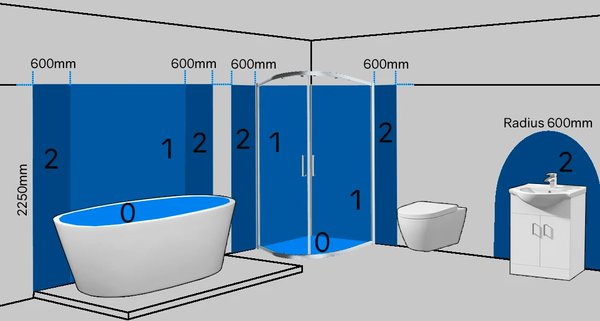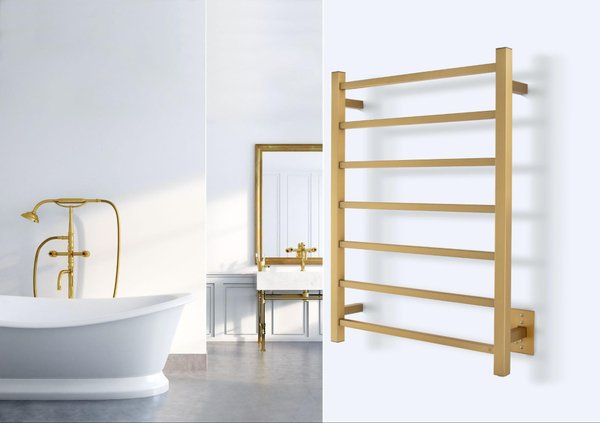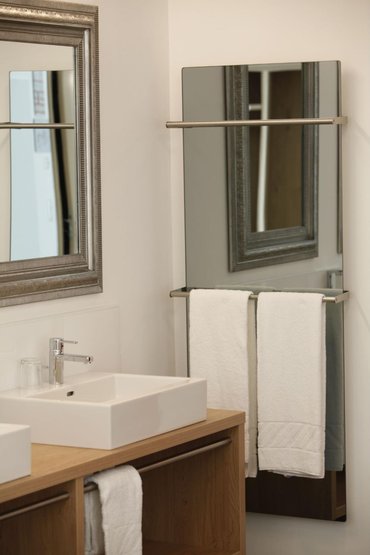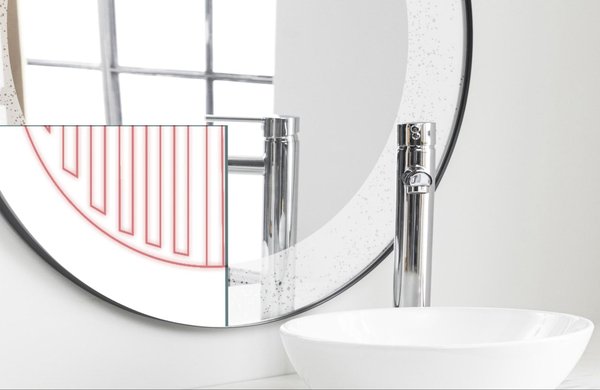Let's detail "Ingress Protection" (IP) ratings, heating zones, and electrical devices as the prime focus to hone in on. We've selected towel warmers, radiant panels, and mirror defoggers in a bathroom as the discussion topics. The heating products allowed in a bathroom depend upon the national electric code, the location of the heating device, and the device's IP Rating. Our goal is to tell you about safety regulations for bathroom heating products.
What is IP?
The IP of a product tells you the level of deterrence a product has for possible damage due to dust, water, or dirt. Two digits make up a product's IP rating, each of the digits that come after having a distinct meaning. The first describes effectively the product's defence against the moving components and how well the equipment shields from external objects. The second specifies the degree of protection the enclosure has against different types of moisture, such as drips, sprays, and even complete submersion.

What are bathroom heating zones?
- What are the rules and requirements for bathroom zones?
- Zone 0
This area is in your bathtub or shower. Any fittings used in this zone must be SELV (Separated Extra Low Voltage - maximum, 12Volts), and the IP rating minimum for this zone is IPX7. The 'X' merely denotes no minimum standard for protection against foreign substances. However, we recommend at least IP67.
- Zone 1 & 2
Zone 1 is the area that extends up to 2.25 (meters) above your bath or shower. A heated towel rail installed in this area must have an IPX4 certification or above. Zone 2 extends up to 2.25 (meters) above your bath or shower and 0.6 (meters) outside of it. The specifications for Zone 1 apply to this zone as well. If there is a chance that water jets will be engirthing the area to spray clean, the IP rating for these zones changes; in this instance, the minimum IP rating required rises to IPX5.
- The 'Outside' Zone 3
Zone 3 is, as its name implies, any region of your bathroom that is not inside zones 0, 1, or 2 you usually cannot clean with water jets. You should consult applicable safety ordinances (criteria for Electrical Installations) or your electrician, as there are no minimum criteria for an IP rating in this zone.
There are four bathroom heating zones: 0, 1, 2, and 3, with zone 3 being referred to as the "outside zone." Although a heater can be mounted in any of these zones, each zone has a distinct minimum IP rating requirement. A bathroom heater's IP rating just describes the degree of defense it offers on the condition it is vulnerable to foreign objects (first digit) and liquids (second digit). For instance, a heated towel rail with an IP10 rating would offer neither protection against liquids nor foreign bodies (solid objects larger than 50mm, such as accidental hand touch). An electric bathroom heater with a grade of 6 or above will be completely protected from dust. This is the highest level for protection against foreign bodies. A grade of 8 indicates that your bathroom heater has high-grade defence when it is immersed in pressurized water for some time. This rating is the maximum possible for liquids.

Towel Warmers

All heated towel warmers can go in Zone 3. We know where the towel rails can go and where they cannot. Most electrical heating racks on WarmlyYours' Towel Warmer product line remain secure from solid particles larger than 1mm and low-velocity water sprays from all sides. Towel warmers are never to be installed in showers, bathtubs, or wet saunas. This product is intended for mud rooms, hotel rooms, and indoor bathrooms, both public and private, on a Ground-Fault Circuit Intercepter circuit (GFCI). Under no circumstances should the towel warmer's brackets be close enough to a water source that the towel warmer heating elements reach the water. Towel warmers do not have this level of durability; on the other hand, towel warmers can be better known as water resistant. The difference is that waterproofed products are impermeable, and water-resistant products are tolerant to minimal water exposure. The actual idyllic location for a heated towel rail is separate from the full spectrum of installation locations themselves. Technically, towel warmers can withstand enough splash to inhabit Zones 1 and 2, shockingly enough. Although, this route won't leave you with suitable accommodations as far as towels are concerned. A towel warmer installed in Zone 3 gives you a much drier towel than one installed above a bath or within a shower area enclosed with glass panels.
Radiant Panels

Electric infrared wall heaters are an excellent method to boost heat in any area. Radiant heater panels use infrared heat to transmit warmth directly from the board to the solid items in the space. These wall-mounted radiant panels are functional and a far more attractive and secure alternative to conventional space heaters for adding additional infrared warmth. EMBER Radiant panels go in a variety of spaces. Various models are recommended depending on the setting and nature of the application. Heating panels should not be used underwater, in damp or humid conditions, or for unintended purposes. The device should stay out of the bathtub or swimming pool; PLUS, the manufacturers of radiant panels did not intend for you to dip it in a liquid. Submerging an EMBER panel will likely lead to water damage over time. Avoid mounting the heating panel next to a bathtub, shower, or swimming pool, especially when the installation is outside. Radiant Panels are "Dust tight" IP-rated and shielded from water sprayed from a nozzle. Infrared radiant panels were granted a level 5 liquid protection score and certainly cleared for Zones 1 and above. Ensure no one using the shower or bath fusses about the heating panel, and keep splashing around the device to a minimum.
Mirror Defoggers
Mirror Defoggers can be positioned behind any mirror to keep it clear and steam-free. Just switch on the lights, and part of the mirror will give you a clean reflection. Installation must adhere to National Electric Code (NEC) guidelines regarding bathroom electrical devices. The structure of this device must follow the directions in the manual and the NEC regulations for bathroom electrical fittings. The Mirror Defogger has to be connected to a GFCI-protected circuit and wired by a qualified electrician. Before installing the product, double-check all of the switches in the bathroom are grounded to ensure you eliminate any danger from the location frequently exposed to dampness. Because Mirror Defoggers have a non-applicable IP rating, mirror defoggers must not go within proximity of a shower, sauna, or steam room. While other electrical devices can hold up against water and moisture, an IP score of 00 provides none.

Why not start using this information right away? Look through our selection of conventional, affordable, trendy, and chrome heated towel rails to get the ideal bathroom warmer right now.